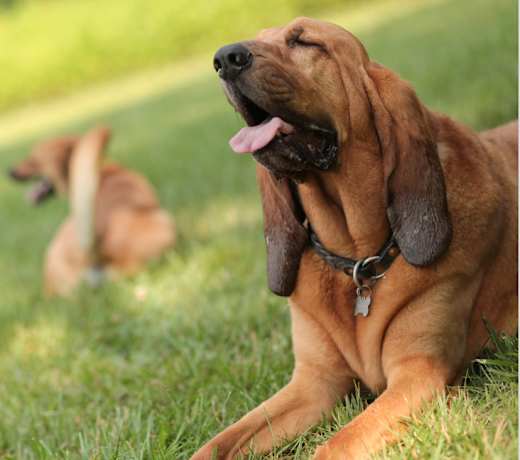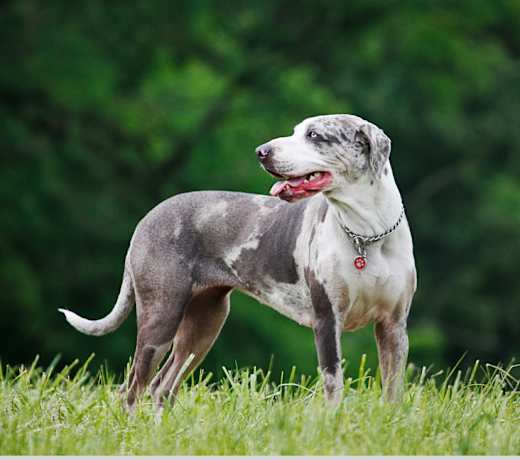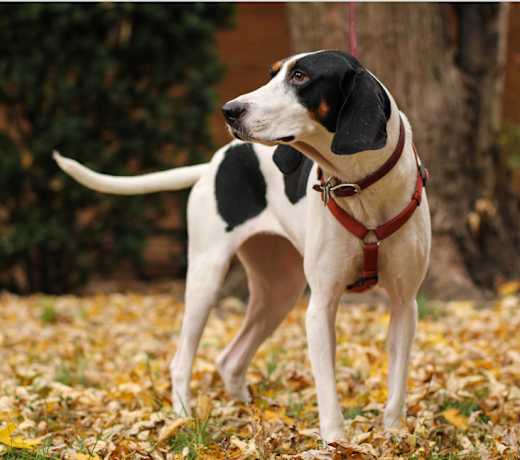Bluetick Coonhounds are large dogs who typically weigh between 50 and 78 pounds and stand around 21 to 27 inches tall.
Bluetick Coonhound
Breed Type: Hound
Common nicknames: Bluetick
Coat: Smooth
Hypoallergenic: No, they will likely trigger allergies.
Temperament: Energetic, affectionate, intelligent, friendly
Life expectancy: 11-12 years
Color & patterns:
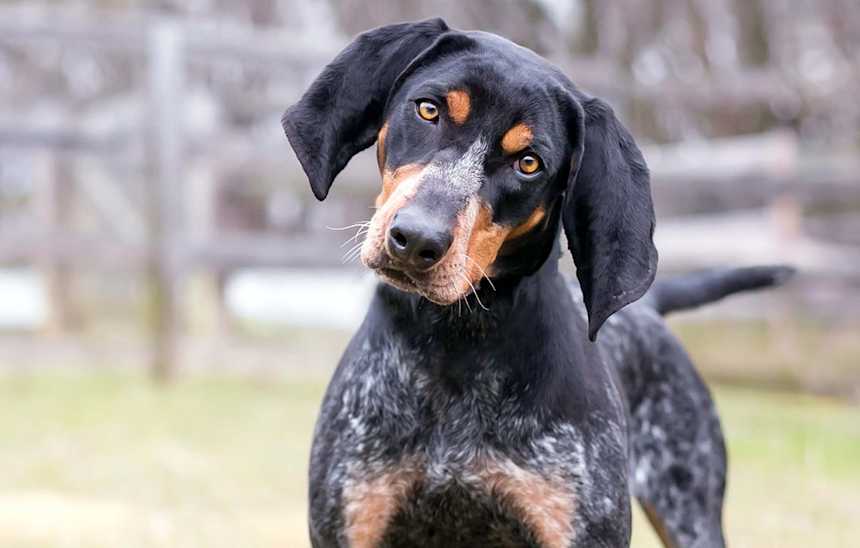
The Bluetick Coonhound is a true adventure enthusiast who is always up for a thrilling outdoor escapade. These spirited pups are medium to large in size and have athletic builds and striking coats, which are adorned with unique blue tick markings. Bluetick Coonhounds are known for their friendly and outgoing nature, making them wonderful playmates for both humans and other pets. Originating in the United States, the Bluetick Coonhound was originally bred for hunting purposes, particularly for tracking raccoons. Their intelligence and keen sense of smell make them exceptional trackers, while their determination and perseverance ensure they never give up on a challenge. They may be known for their hunting instincts, but they’re also loyal and affectionate family dogs who are always up for an exciting game of fetch or a long hike in the great outdoors.
Bluetick Coonhound characteristics
Learn about about Bluetick Coonhound basics like their fur colors, shedding levels, how much grooming they need, and other Bluetick Coonhound facts.
Average height
21-27 inches (53.3-68.6cm)
Average weight
50-78 pounds (22.7-35.4 kg)
Average lifespan
11-12 years
Exercise needs
Grooming needs
Full-grown size
Good with cats
Good with kids
Training Aptitude
Are Bluetick Coonhounds hypoallergenic?
No, Bluetick Coonhounds are not hypoallergenic. They have a short, dense coat that sheds moderately throughout the year. Regular grooming, including brushing their coats and bathing them occasionally, can help reduce the amount of loose fur and dander, which may lessen allergy symptoms for people who are mildly allergic to dogs.
Do Bluetick Coonhounds have webbed feet?
Yes, Bluetick Coonhounds have webbed feet. The webbing between their toes helps them swim more efficiently and is especially useful since the breed is often used for hunting or tracking game.
Do Bluetick Coonhounds drool?
No, Bluetick Coonhounds are not heavy droolers. Some Bluetick Coonhounds may drool occasionally, especially after eating or drinking or when excited or stressed. Some Bluetick Coonhounds may drool more than others, but it is not a major characteristic of the breed.
Do Bluetick Coonhounds shed?
Yes, Bluetick Coonhounds do shed, but their shedding is typically moderate and manageable with regular grooming. The Bluetick Coonhound needs regular brushing to keep the shedding at bay and regular bathing to avoid their distinctive “doggy” odor. Using a grooming mitt or a brush designed for short coats can be effective in keeping their coat healthy and reducing loose hair around the home.
What color is a Bluetick Coonhound?
The Bluetick Coonhound is tricolor, with their trademark “bluetick” color (black markings on a white background, which gives the impression of a dark blue color). The ticking pattern consists of small specks or spots of lighter blue or white on the coat. This ticking is evenly distributed over the body and gives the coat a mottled appearance. They also often have tan markings on the face, chest, legs, and belly.
How long do Bluetick Coonhounds live?
A healthy Bluetick Coonhound will live to be 11 to 12 years old. However, individual lifespans can vary based on factors such as genetics, diet, exercise, healthcare, and overall lifestyle. Providing proper care, regular veterinary check-ups, a balanced diet, and maintaining a healthy weight can contribute to helping dogs of all breeds live long and healthy lives.
When do Bluetick Coonhounds stop growing?
Bluetick Coonhounds typically reach their full adult size between 12 to 18 months old. They will reach their full height at about one year old and their full weight at about 18 months old.
Bluetick Coonhound history
Learn about where the Bluetick Coonhound came from.
What are Bluetick Coonhounds bred for?
Bluetick Coonhounds are a scenthound breed originally bred for hunting and tracking game, particularly raccoons. They are known for their ability to trail and tree raccoons, hence the name “Coonhound.” Bluetick Coonhounds are great at scenting, stamina, and endurance, and “treeing” game, which means tracking the scent of small game animals until they find them cornered or up a tree. They excel in their role as working dogs and continue to be used for hunting as well as for companionship due to their friendly and loyal nature.
Where are Bluetick Coonhounds from?
Bluetick Coonhounds were developed in the American South, particularly Louisiana, in the 19th century. The breed is a combination of English Foxhounds and French hounds, such as the similarly blue-coated Grand Blue de Gascogne.
Bluetick Coonhound temperament
Learn about about the Bluetick Coonhound temperament and how well they fit into your lifestyle, home environment, and family.
Do Bluetick Coonhounds bark a lot?
Yes, Bluetick Coonhounds tend to bark a lot. They have a distinctive “baying” bark that is sometimes called a “bawl” or a choppy howl. This baying can be quite loud and carries over long distances. Like most hounds, Bluetick Coonhounds are fond of using their voice to communicate all manner of things, though they can be discouraged from barking as frequently with proper training and exercise.
Are Bluetick Coonhounds good family dogs?
Yes, Bluetick Coonhounds are fantastic family companions, provided their family is a good match for the breed. Like most hounds, these energetic and affectionate dogs need plenty of exercise, so an active family that will keep this dog physically stimulated is best. Your Bluetick Coonhound may love activities like hiking, running, or participating in canine sports. This is a breed that loves to be around humans and included in all their daily activities. They are true, devoted companions.
Are Bluetick Coonhounds good with cats?
Yes, Bluetick Coonhounds are capable of befriending cats, especially those they are raised alongside and sometimes those they’re introduced to later in life, too. While they were bred to chase small, furry things, their relationship with cats depends on the individual dog (and cat) involved.
Are Bluetick Coonhounds good with other dogs?
Yes, Bluetick Coonhounds typically get along with other dogs. They are friendly, sociable, and good-natured and can form strong bonds with other dogs, especially if introduced to them from a young age. However, their prey drive may kick in with smaller animals, and they can compete for dominance with other dogs, particularly of the same sex.
Are Bluetick Coonhounds protective?
Yes, Bluetick Coonhounds are protective to an extent. They often form strong bonds with their human family members and may show loyalty and a desire to keep their family safe. But while Bluetick Coonhounds may make a good watchdog, they’re typically too friendly to act as a designated guard dog.
Do Bluetick Coonhounds like to swim?
Yes, Bluetick Coonhounds often enjoy the physical activity of swimming as well as cooling off in water after exercise. They have a natural affinity for water, and their webbed feet make them adept swimmers. While individual preferences may vary, many Bluetick Coonhounds have a natural inclination towards swimming.
How fast can a Bluetick Coonhound run?
Bluetick Coonhounds can run 25 to 30 miles per hour in short bursts. They are known for their speed and endurance, essential traits for hunting and tracking game over varied terrain. While specific speed measurements can vary based on individual dogs, they are generally athletic dogs with the physical capabilities to match.
Are Bluetick Coonhounds easy to train?
No, Bluetick Coonhounds can be challenging to train. They are intelligent dogs but can have a bit of an independent and stubborn streak. This means they may sometimes choose to do things their own way rather than follow commands immediately.
That said, training any dog takes substantial time and effort, regardless of breed. Proper socialization from a young age is important to help Bluetick Coonhounds (and any dog) develop good manners and social skills. A confident trainer using short sessions and plenty of positive reinforcement is key.
Are Bluetick Coonhounds good with kids?
Yes, Bluetick Coonhounds enjoy the company of children and are wonderful around kids they have been raised alongside, though they can be a bit rambunctious for smaller children. They may have a lot of energy to burn, which can make them good playmates for children who enjoy active play.
As with any breed, it is recommended that your child is always supervised when interacting with your Bluetick Coonhound to keep both the child and dog safe. Teaching children how to properly approach and handle dogs is crucial to ensure positive experiences for both the dog and the child, as is teaching dogs how to interact gently with children.
Bluetick Coonhound health
Learn about about the Bluetick Coonhound health outlook and what diseases they may be prone to at various stages of their life.
Are Bluetick Coonhounds healthy?
The Bluetick Coonhound is overall a healthy, robust breed but, like all dogs, can be prone to diseases such as:
Hip and/or elbow dysplasia: Hip and elbow dysplasia are two of the most common skeletal diseases seen in dogs. They are similar diseases in which either the hip or elbow joint has grown abnormally or is misshapen. The abnormal shape prevents the joints and sockets from properly meeting one another, resulting in rubbing and grinding instead of sliding smoothly. Unlike in hip dysplasia, where the main problem is joint instability, the abnormalities seen in elbow dysplasia often result in pieces of bone and/or cartilage breaking loose and irritating the joint tissues. Over time, the rubbing from dysplasia can cause a variety of issues such as pain, lameness and secondary osteoarthritis. Surgery can be done to fix the joint if diagnosed before the onset of arthritis. If you are rescuing a Bluetick Coonhound, have them checked out by a vet to see if they have or are prone to getting dysplasia so you know what they will be able to handle in terms of activities and exercise.
Patellar luxation: Also known as slipped kneecaps, patellar luxation is a common problem in many dog breeds. It occurs when slight abnormalities cause the knee joint to slide in and out of place. This can cause pain and occasional lameness. Surgical treatment is available for severe cases, although many dogs lead normal lives without treatment.
Lysosomal storage disease: This term is used to describe a group of disorders where certain metabolic enzymes necessary for normal body function are not produced by the body.
Gastric dilatation-volvulus: This sudden, painful and life-threatening swelling and twisting of the abdomen.
Popular Bluetick Coonhound mixes
Bluetick Coonhounds are commonly mixed with the Rat Terrier breed to produce Bluetick Rat Terriers.
Bluetick Rat Terrier (Bluetick Coonhound + Rat Terrier)
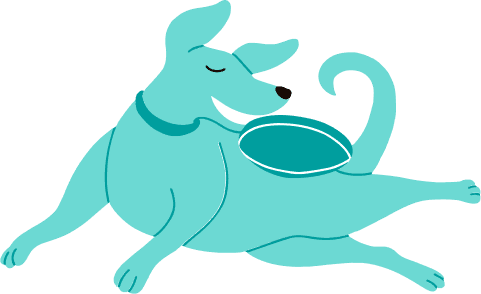
Find Bluetick Coonhound puppies near you
Adopting a Bluetick Coonhound
We don't see any Bluetick Coonhounds available for adoption in your exact location or cities near you, but here are some adorable similar breeds in Beverly Hills, CA.

Meep
Catahoula Leopard Dog
Male, 1 yr 7 mos
Los Angeles, CA
House-trained
Spayed or Neutered
Shots are up-to-date

Charli
Catahoula Leopard Dog
Female, 1 yr 6 mos
Los Angeles, CA
House-trained
Spayed or Neutered
Shots are up-to-date

Chica
Catahoula Leopard Dog Mixed Breed (Medium)
Female, 6 yrs 4 mos
Los Angeles, CA
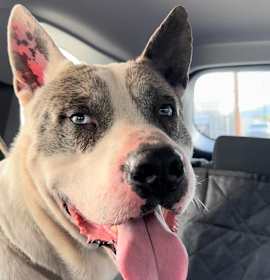
Sweet Romeo
Catahoula Leopard Dog Bull Terrier
Male, young
Los Angeles, CA
House-trained
Spayed or Neutered
Shots are up-to-date

*BLAKE
Bloodhound Doberman Pinscher
Male, 11 mos
Burbank, CA

*JAKE
Bloodhound Doberman Pinscher
Male, 11 mos
Burbank, CA

Bourbon
Catahoula Leopard Dog
Male, puppy
Los Angeles, CA
House-trained
Shots are up-to-date

PEACH
Catahoula Leopard Dog
Female, 1 yr
Los Angeles, CA

Meep
Catahoula Leopard Dog
Male, 1 yr 7 mos
Los Angeles, CA
House-trained
Spayed or Neutered
Shots are up-to-date

Charli
Catahoula Leopard Dog
Female, 1 yr 6 mos
Los Angeles, CA
House-trained
Spayed or Neutered
Shots are up-to-date

Chica
Catahoula Leopard Dog Mixed Breed (Medium)
Female, 6 yrs 4 mos
Los Angeles, CA

Sweet Romeo
Catahoula Leopard Dog Bull Terrier
Male, young
Los Angeles, CA
House-trained
Spayed or Neutered
Shots are up-to-date

*BLAKE
Bloodhound Doberman Pinscher
Male, 11 mos
Burbank, CA

*JAKE
Bloodhound Doberman Pinscher
Male, 11 mos
Burbank, CA

